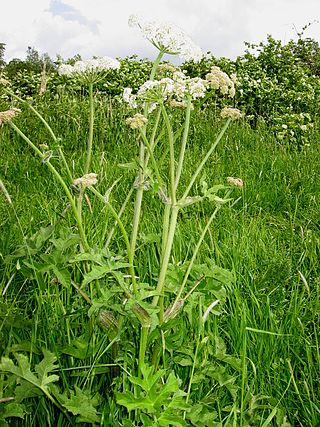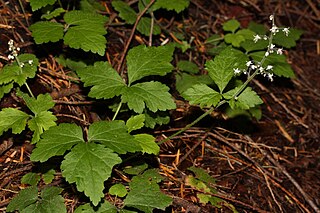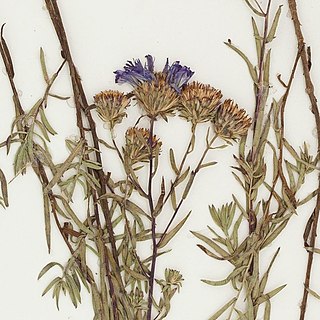
Trillium erectum, the red trillium, also known as wake robin, purple trillium, bethroot, or stinking benjamin, is a species of flowering plant in the family Melanthiaceae. The plant takes its common name "wake robin" by analogy with the European robin, which has a red breast heralding spring. Likewise Trillium erectum is a spring ephemeral plant whose life-cycle is synchronized with that of the forests in which it lives. It is native to the eastern United States and eastern Canada from northern Georgia to Quebec and New Brunswick.

Hepatica is a genus of herbaceous perennials in the buttercup family, native to central and northern Europe, Asia and eastern North America. Some botanists include Hepatica within a wider interpretation of Anemone.

Eriophorum is a genus of flowering plants in the family Cyperaceae, the sedge family. They are found in the cool temperate, alpine, and Arctic regions of the Northern Hemisphere, primarily in the middle latitudes of North America, Europe, and Asia.

Heracleum sphondylium, commonly known as hogweed or common hogweed, is a herbaceous perennial plant in the carrot family Apiaceae, which includes fennel, cow parsley, ground elder and giant hogweed. It is native to most of Europe, western Asia and northern Africa, but is introduced in North America and elsewhere. Other common names include cow parsnip. The flowers provide a great deal of nectar for pollinators.

Otto Wilhelm Sonder was a German botanist and pharmacist.

Nikolai Stepanovich Turczaninow was a Russian botanist and plant collector who first identified several genera, and many species, of plants.

Tiarella trifoliata, the three-leaf foamflower, is a species of flowering plant in the family Saxifragaceae. The specific name trifoliata means "having three leaflets", a characteristic of two of the three recognized varieties. Also known as the laceflower or sugar-scoop, the species is found in shaded, moist woods in western North America.

Kleinia petraea is a species of flowering plant in the genus Kleinia and family Asteraceae which was previously considered to be a species of Senecio. Native to Kenya and Tanzania, it is colloquially known as creeping jade, trailing jade or weeping jade due to its resemblance to the unrelated Jade plant.

Salvia indica is a species of herbaceous perennial plant belonging to the family Lamiaceae. It is native to a wide region of Western Asia that includes Israel, Iraq, Iran and Turkey. It was first described by the taxonomist Carl Linnaeus in 1753. It is unknown why he gave it the specific epithet indica, since the plant is not from India. While Salvia indica is classified as a herbaceous perennial, in cultivation individual plants often live no longer than two years.
Poa triodioides, synonyms including Austrofestuca littoralis, is a species of flowering plant in the grass family Poaceae, native to southwestern and southeastern Australia and to New Zealand.
Jalantzia is a genus of flowering plants in the aster tribe Astereae within the sunflower family Asteraceae. It was previously known as VernoniopsisHumbert, an illegitimate name. Its species are native to Madagascar.

Salvia canescens, the hoary sage, is a herbaceous perennial that is endemic to the Caucasus Mountains. The specific epithet, canescens, refers to the off-white hairs covering the leaves.

Euphronia is a genus of three species of shrubs native to northern South America and is the only genus in the family Euphroniaceae. It was previously classified in the Vochysiaceae family and elsewhere due to its unique floral features, but the APG III system of 2009 recognized Euphroniaceae as distinct and placed Euphronia in it. Based on molecular data from the rbcL gene, it is sister to the Chrysobalanaceae.

Desmodium glabellum is a species of flowering plant in the legume family Fabaceae. It is native to the eastern and central United States. It is commonly called Dillenius' tick-trefoil in honor of Johann Dillenius, a British botanist of German birth. It is also known as the tall tick-trefoil.

Acilepis ornata is a species of plant native to India. The species was first described by William Alexander Talbot in 1898 as Vernonia ornata.

Kimnachia is a monotypic genus of cacti. Its only species is Kimnachia ramulosa, synonym Pseudorhipsalis ramulosa, which is native from southern Mexico to northern South America and also found in Jamaica.
Victoria Anne Wassell Graham née Smith, is a British botanist who worked at the Natural History Museum.

Symphyotrichum turneri is a species of flowering plant in the family Asteraceae native to Durango, Mexico.

Lucy Adeline Briggs was an American watercolor botanical artist and botanical collector.
Jalantzia lokohensis is a species of flowering plant in the family Asteraceae, native to Madagascar.
















